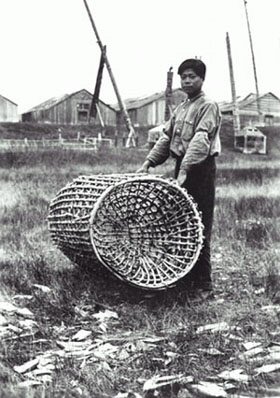S A L M O N O N T H E S K E E N A
| |||||||||||||||
| Home Page | Introduction | 7000 BC - 1790 AD | 1790 AD - 1920 AD | Credits/Contact Us | |||||||||||

|

|
Fish weirs and basket traps were used by the Gitksan on the upper Skeena River and on its many tributaries. Basket traps could be used with a natural weir, such as a dam of rocks that created a waterfall where salmon were forced to jump to reach their spawning grounds. The traps were placed below the falls and collected the salmon that fell back. Such traps were also used along the lower Skeena where the Tsimshian placed them at the foot of rapids near the shoreline. All along the Skeena River, where there were no natural falls or rapids, each village built a fish weir, and basket traps belonging to each lineage were placed along the weir. The weirs were barricades made of stakes of cedar, sometimes elaborately decorated with family crests to show ownership and to honour the salmon people. A tool known as a pile driver was used to pound the stakes into the riverbed and rocks were placed at the base of the stakes to provide a firm foundation for the weir. An oral history from Temlaxam, an ancient Gitksan village, gives some detail as to how the lattice for these weirs was made. |

|
"The people were all living in Temlaxam, in laxsi'yans - the month of leaves. They all helped in making a t'in, fish fence. They dammed the Skeena River right across with the t'in. Each man had a small section of his own to build up. Everybody brought roots and slats and reeds to make the t'in. After this was ready, they began to make the woo', each man furnishing thin poles, and women went to pull up roots for tying. Other women made the roots pliable by running smooth stones on them, so that they would be easily tied. The work was all divided up between them. The heads of the houses were given a portion of the t'in called woo' - fish basket. Every family had its own part. After it was built, it was divided between the crests. And once finished, everybody waited for the arrival of the salmon." |
The head chiefs of the village ensured that each family or lineage harvested enough fish to last the year, but during the fishing season, at regular intervals, the traps were removed and fish were allowed to proceed upstream to spawn. The chiefs were trained to manage the fishery so that the salmon stocks were never depleted. |
 |
There were also fish weirs with ramps along the top, where people stood and speared the fish or harvested them with dip nets. When these were built in the smaller streams like the one shown here, the people stood on the shore or in the stream. |
|
| COLLECTIONS weir artifacts   
net artifacts     
how the Tsimshian learned to make fishing nets |